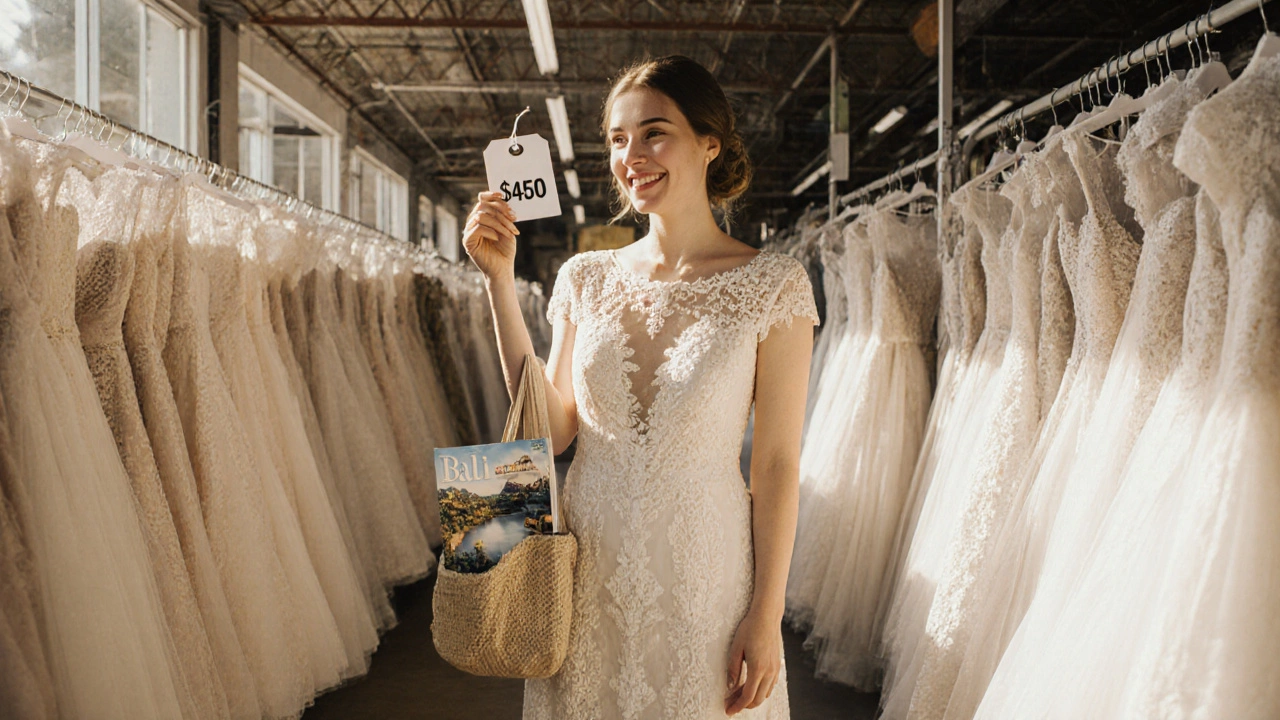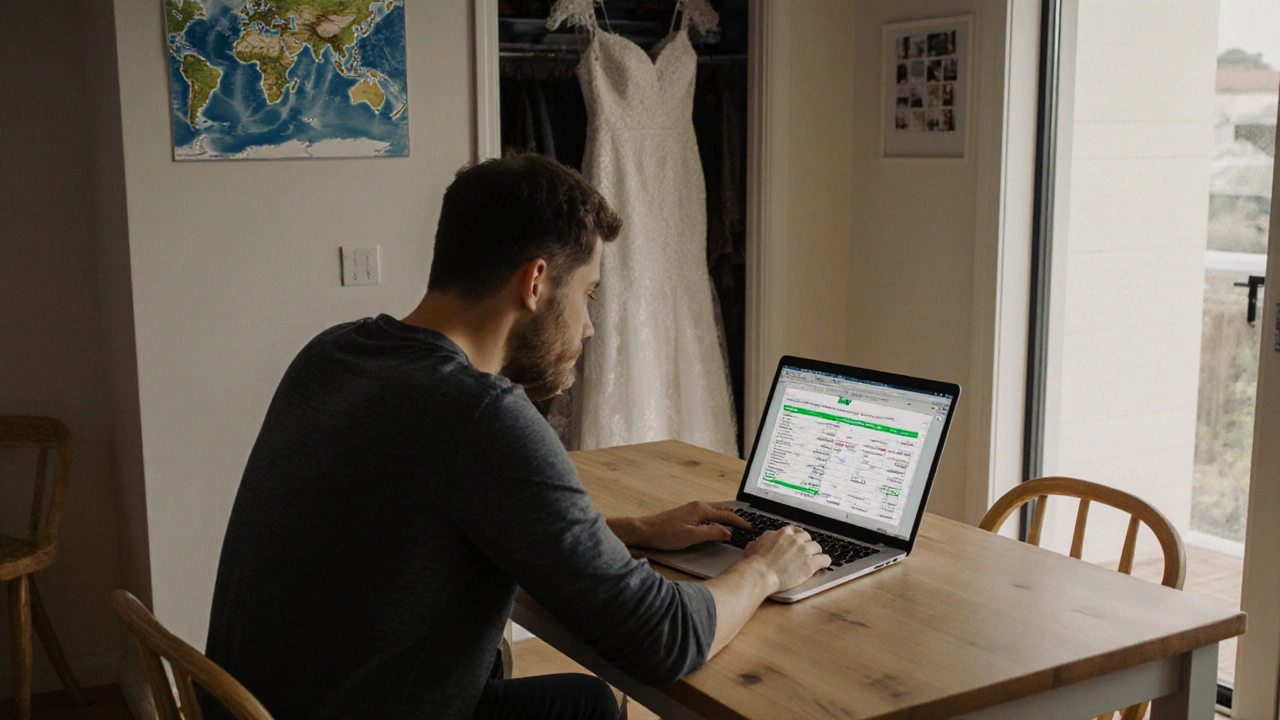Who Pays for the Wedding Dress? Real Talk on Honeymoon Costs and Traditions

- Oct, 28 2025
- 0 Comments
- Aaron Blackwood
Let’s be real-weddings are expensive. And the wedding dress? That’s often the single biggest item on the whole list. You’ve seen the movies: the bride’s mom drops a suitcase full of cash on a lace gown in a fancy boutique. But in 2025, that’s not how most couples live. So who actually pays for the wedding dress? And how does that connect to your honeymoon budget? Spoiler: it’s not about tradition anymore. It’s about what works for you.
It’s Not Your Mom’s Wedding Anymore
Forty years ago, the bride’s family paid for everything. The dress, the venue, the cake, the honeymoon. End of story. But today? Fewer than 12% of couples in New Zealand follow that old script, according to a 2024 survey by the New Zealand Wedding Industry Association. Most brides today are working, saving, or even earning more than their partners. The idea that a parent should foot the bill for a dress they didn’t choose? That doesn’t sit right with a lot of people.What you’ll hear now: "I’ve been saving for this since I was 18." Or, "My partner and I split everything 50/50." Or, "My sister lent me $800 and I’m paying her back in monthly coffee runs."
The wedding dress isn’t a gift anymore. It’s a personal investment. And that changes everything.
How Much Does a Wedding Dress Actually Cost?
Let’s talk numbers. In New Zealand, the average wedding dress in 2025 runs between $1,200 and $3,500. If you’re buying off-the-rack from a boutique like David’s Bridal or a local designer in Wellington, you’re looking at $1,500-$2,500. Custom-made? That’s $3,000-$7,000. And if you’re flying to Sydney or London for a designer gown? Add flights, accommodation, and a few stress-induced massages.Compare that to a honeymoon. A two-week trip to Bali for two? Around $4,000-$6,000. A luxury train ride through the Canadian Rockies? $8,000. A beach villa in the Maldives? $10,000+. The dress isn’t even the most expensive item anymore. But because it’s visible-because you wear it for one day-it feels like the biggest expense.
Here’s the truth: if you’re spending $4,000 on a dress and then putting your honeymoon on a credit card, you’re setting yourself up for a rocky start. And that’s not romantic. It’s just risky.
Who Pays? The Modern Rules
There’s no law. No family council. No church rulebook. But here’s what most couples in 2025 are doing:- You pay for it yourself. 58% of brides in the 2024 survey said they paid for their own dress, either from savings, side gigs, or a wedding fund they started years ago.
- Your partner pays for it. 22% said their fiancé covered it as a gift. Not because it’s tradition-but because they wanted to surprise them.
- You split it. 11% split the cost with their partner, often as part of a shared wedding budget.
- A parent helps. Only 9% had a parent pay for the entire dress. But in 60% of those cases, the parent also helped with the honeymoon.
Notice something? The people who get help with the dress are the same ones who get help with the honeymoon. That’s not coincidence. It’s strategy.

The Dress-Honeymoon Connection
Here’s where most couples get tripped up: they treat the dress and the honeymoon like two separate things. They’re not. They’re both part of the same financial picture.If you’re spending $3,500 on a dress you’ll only wear once, you’re giving up $3,500 that could go toward a romantic getaway. That’s a night in a luxury suite in Queenstown. A private hot spring in Rotorua. A helicopter tour over Fiordland. That’s a memory you’ll keep for decades.
One couple I talked to in Christchurch-both teachers-decided to skip the $3,200 designer gown. They bought a vintage lace dress for $450 on Etsy, had it altered for $180, and put the rest-$2,570-into their honeymoon fund. They ended up spending 10 days in Bali, eating street food, staying in a beach bungalow, and snorkeling every morning. They still say it was the best part of their wedding.
Another couple in Auckland bought a $2,800 gown. Then they took out a $5,000 personal loan to pay for their honeymoon in Santorini. Two years later, they’re still paying it off. They don’t talk about the dress. They talk about the debt.
There’s no right answer. But there’s a smarter one.
What to Do Instead of Following Tradition
Forget the old rules. Here’s what actually works:- Set a total wedding budget first. Not just for the dress. For everything. Venue, food, rings, photos, hair, makeup, transportation, and the honeymoon. Be honest. What can you really afford without going into debt?
- Decide what matters most to you. Is it the dress? The photos? The food? The trip? Put your money where your heart is. If you dream of a beach sunrise in Bora Bora, then spend less on the dress. If you’ve always wanted to wear a custom-made lace gown, then skip the fancy honeymoon package.
- Ask for help-but only if it’s offered. Don’t pressure your parents. Don’t guilt-trip your partner. If someone says, "I’d love to help with your dress," then you can say yes. But if they say, "We’re saving for our retirement," don’t push. That’s not selfish. That’s responsible.
- Think long-term. Your marriage isn’t defined by the dress you wore. It’s defined by how you handle money, stress, and joy together. Start that right.

Real Stories, Real Choices
A friend of mine in Dunedin got married last year. She bought her dress from a thrift store for $80. She spent $120 on alterations. She didn’t tell her mom until after the wedding. Her mom cried-not because it wasn’t expensive, but because she realized her daughter had already figured out what mattered. They used the $2,500 they saved to fly to Fiji for a week. No resort. No fancy dinner. Just hammocks, coconuts, and quiet mornings.Another woman in Tauranga bought a $4,000 gown from a designer in Sydney. Her fiancé paid for it. He also paid for the honeymoon. But he didn’t have savings. He used his credit card. They’re still paying it off. She says she loves the dress. But she hates the monthly statement.
There’s no moral high ground here. Just choices.
What About the Groom’s Suit?
You might be wondering-what about the groom? Traditionally, he pays for his own suit. And that’s still mostly true. But now? More grooms are asking their partners to chip in. Or they’re splitting the cost of matching outfits. Or they’re renting. A good rental suit in New Zealand costs $150-$250. That’s less than a third of what a custom suit runs. And it’s easier on the wallet.One couple I met in Nelson rented matching linen suits for $200 each. They used the $1,200 they saved to book a hot air balloon ride over Marlborough’s vineyards on their honeymoon. They said it was the most memorable part of their wedding day.
Final Thought: Your Marriage Starts With Your Choices
The wedding dress isn’t the center of your marriage. It’s just a piece of fabric. What matters is how you decide to spend your money, your time, and your trust.So if you’re wondering who pays for the dress-ask yourself: what do I want my marriage to look like in five years? Do I want to be debt-free and traveling? Or do I want to be paying off a $3,000 gown I barely remember wearing?
There’s no shame in wanting a beautiful dress. But there’s wisdom in knowing when to say, "I’d rather have this memory than that gown."
Who traditionally pays for the wedding dress?
Traditionally, the bride’s family paid for the wedding dress. But in 2025, fewer than 10% of couples follow this rule. Most brides pay for their own dress, their partner pays for it as a gift, or they split the cost as part of a shared budget. Tradition is fading because modern couples are making choices based on their finances, not outdated norms.
How much should I spend on a wedding dress?
There’s no magic number, but most couples in New Zealand spend between $1,200 and $3,500. A good rule of thumb: don’t spend more than 5% of your total wedding budget on the dress. If your wedding budget is $15,000, aim for $750 or less. If you’re spending $4,000 on the dress, make sure your honeymoon isn’t going on a credit card.
Can I ask my parents to pay for my dress?
You can ask-but don’t expect it. Many parents today are saving for retirement, helping with their kids’ education, or dealing with their own expenses. If they offer to help, say thank you. If they don’t, don’t take it personally. Your dress is your choice, and your marriage is your future. You can still have a beautiful dress without their money.
Should I buy a new dress or go secondhand?
Secondhand dresses are a smart, popular choice. Many brides buy gently used gowns from platforms like Stillwhite, PreOwnedWeddingDresses, or local Facebook groups. You can save 50-80% and still look stunning. Plus, buying secondhand means you’re not contributing to fast fashion. A $500 dress can look just as beautiful as a $3,000 one-especially when you’ve saved $2,500 for your honeymoon.
Does paying for the dress affect who pays for the honeymoon?
It often does. Couples who spend less on the dress tend to have more flexibility for the honeymoon. If one person pays for the dress, they’re more likely to also help fund the trip. If you’re splitting the dress cost, you’re more likely to split the honeymoon too. The key is to treat the dress and honeymoon as part of the same budget-not separate items.
What if my partner wants a fancy dress but I want to save for travel?
Talk about it-without blame. Say, "I love the idea of you in a beautiful dress, but I also dream of us traveling somewhere unforgettable. Can we find a dress that makes you feel amazing without breaking the bank?" Often, the compromise is a stunning dress that’s $1,000 instead of $3,500-and a trip you’ll remember forever. It’s not about giving up. It’s about choosing what lasts.